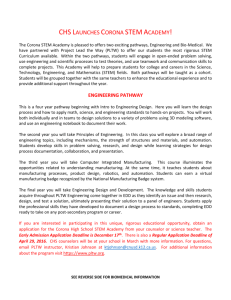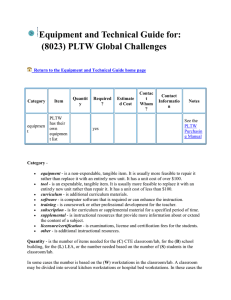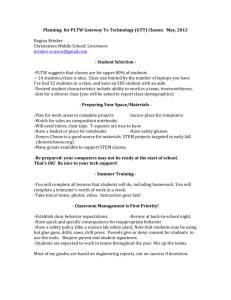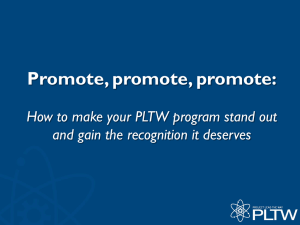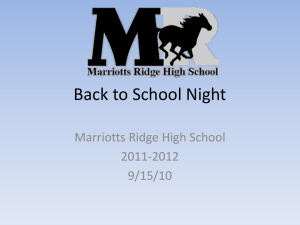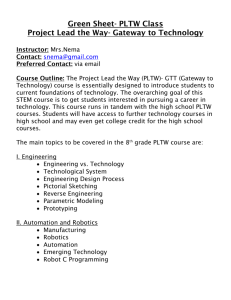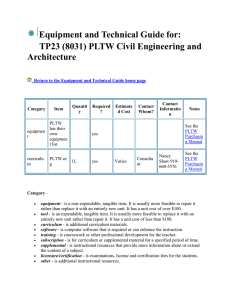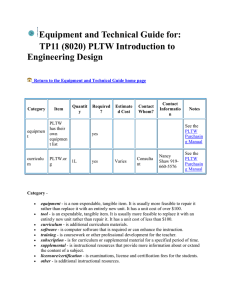Regional STEM High School
advertisement
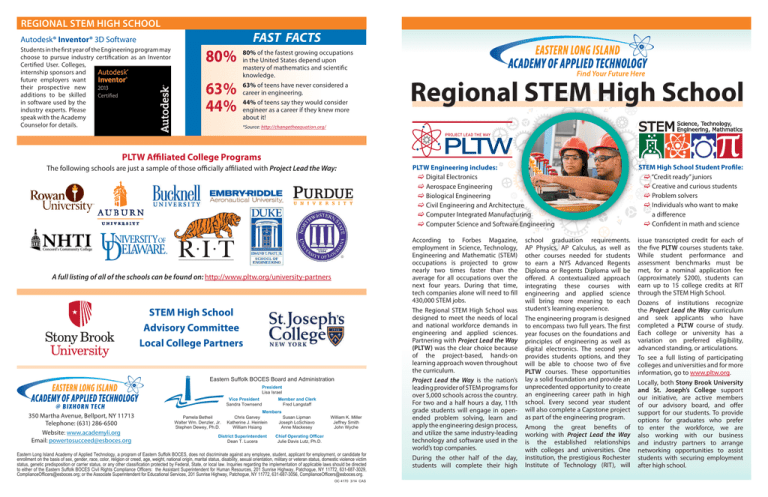
Regional STEM High School FAST FACTS Autodesk® Inventor® 3D Software Students in the first year of the Engineering program may choose to pursue industry certification as an Inventor Certified User. Colleges, internship sponsors and future employers want their prospective new additions to be skilled in software used by the industry experts. Please speak with the Academy Counselor for details. 80% 63% 44% 80% of the fastest growing occupations in the United States depend upon mastery of mathematics and scientific knowledge. 63% of teens have never considered a career in engineering. 44% of teens say they would consider engineer as a career if they knew more about it! Regional STEM High School Technology, STEM Science, Engineering, Mathmatics *Source: http://changetheequation.org/ PLTW Affiliated College Programs The following schools are just a sample of those officially affiliated with Project Lead the Way: A full listing of all of the schools can be found on: http://www.pltw.org/university-partners STEM High School Advisory Committee Local College Partners EASTERN LONG ISLAND ACADEMY OF APPLIED TECHNOLOGY Eastern Suffolk BOCES Board and Administration President Lisa Israel Vice President Sandra Townsend BIXHORN TECH 350 Martha Avenue, Bellport, NY 11713 Telephone: (631) 286-6500 Website: www.academyli.org Email: powertosucceed@esboces.org Pamela Betheil Walter Wm. Denzler, Jr. Stephen Dewey, Ph.D. Member and Clerk Fred Langstaff Members Chris Garvey Susan Lipman Katherine J. Heinlein Joseph LoSchiavo William Hsiang Anne Mackesey District Superintendent Dean T. Lucera William K. Miller Jeffrey Smith John Wyche Chief Operating Officer Julie Davis Lutz, Ph.D. Eastern Long Island Academy of Applied Technology, a program of Eastern Suffolk BOCES, does not discriminate against any employee, student, applicant for employment, or candidate for enrollment on the basis of sex, gender, race, color, religion or creed, age, weight, national origin, marital status, disability, sexual orientation, military or veteran status, domestic violence victim status, genetic predisposition or carrier status, or any other classification protected by Federal, State, or local law. Inquiries regarding the implementation of applicable laws should be directed to either of the Eastern Suffolk BOCES Civil Rights Compliance Officers: the Assistant Superintendent for Human Resources, 201 Sunrise Highway, Patchogue, NY 11772, 631-687-3029, ComplianceOfficers@esboces.org; or the Associate Superintendent for Educational Services, 201 Sunrise Highway, Patchogue, NY 11772, 631-687-3056, ComplianceOfficers@esboces.org. OC 4170 3/14 CAS PLTW Engineering includes: c Digital Electronics c Aerospace Engineering c Biological Engineering c Civil Engineering and Architecture c Computer Integrated Manufacturing c Computer Science and Software Engineering According to Forbes Magazine, employment in Science, Technology, Engineering and Mathematic (STEM) occupations is projected to grow nearly two times faster than the average for all occupations over the next four years. During that time, tech companies alone will need to fill 430,000 STEM jobs. The Regional STEM High School was designed to meet the needs of local and national workforce demands in engineering and applied sciences. Partnering with Project Lead the Way (PLTW) was the clear choice because of the project-based, hands-on learning approach woven throughout the curriculum. Project Lead the Way is the nation’s leading provider of STEM programs for over 5,000 schools across the country. For two and a half hours a day, 11th grade students will engage in openended problem solving, learn and apply the engineering design process, and utilize the same industry-leading technology and software used in the world’s top companies. During the other half of the day, students will complete their high school graduation requirements. AP Physics, AP Calculus, as well as other courses needed for students to earn a NYS Advanced Regents Diploma or Regents Diploma will be offered. A contextualized approach integrating these courses with engineering and applied science will bring more meaning to each student’s learning experience. The engineering program is designed to encompass two full years. The first year focuses on the foundations and principles of engineering as well as digital electronics. The second year provides students options, and they will be able to choose two of five PLTW courses. These opportunities lay a solid foundation and provide an unprecedented opportunity to create an engineering career path in high school. Every second year student will also complete a Capstone project as part of the engineering program. Among the great benefits of working with Project Lead the Way is the established relationships with colleges and universities. One institution, the prestigious Rochester Institute of Technology (RIT), will STEM High School Student Profile: c “Credit ready” juniors c Creative and curious students c Problem solvers c Individuals who want to make a difference c Confident in math and science issue transcripted credit for each of the five PLTW courses students take. While student performance and assessment benchmarks must be met, for a nominal application fee (approximately $200), students can earn up to 15 college credits at RIT through the STEM High School. Dozens of institutions recognize the Project Lead the Way curriculum and seek applicants who have completed a PLTW course of study. Each college or university has a variation on preferred eligibility, advanced standing, or articulations. To see a full listing of participating colleges and universities and for more information, go to www.pltw.org. Locally, both Stony Brook University and St. Joseph’s College support our initiative, are active members of our advisory board, and offer support for our students. To provide options for graduates who prefer to enter the workforce, we are also working with our business and industry partners to arrange networking opportunities to assist students with securing employment after high school. Regional STEM High School Regional STEM High School Junior Year Course Schedule Senior Year Course Schedule Students will take the following courses: Students will take the following courses: c PLTW Engineering* – 4 periods cA lgebra 2/Trigonometry or Pre-Calculus or AP Calculus AB* c AP Physics* or Regents Physics c English 11 c Physical Education/Health c U.S. History c PLTW Engineering* – 4 periods c Internship c English c Pre-Calculus or AP Calculus AB* c AP Chemistry* or Regents Chemistry c Economics/Government c Physical Education Please note: Students will also receive an Art credit. The Engineering for Design curriculum was developed using the NYSED Drawing for Production curriculum. Engineering/Project Lead the Way Curriculum, Year 1 Engineering/Project Lead the Way Curriculum, Year 2 Students will take NYS Regents in US History, English, and Algebra 2/Trigonometry as needed. Math course placement will be determined based upon the student’s prior course history. Introduction to Engineering Design Students dig deep into the engineering design process, applying math, science, and engineering standards to hands-on projects. They work both individually and in teams to design solutions to a variety of problems using 3D modeling software. Students enrolled in year one will help us determine the PLTW courses we will offer in the second year. Working with our students and the Advisory Board, students will choose two of the following five courses, in addition to the Capstone Course: Students will access online learning to supplement their academic classroom experiences using AccelerateU. Principles of Engineering Through problems that engage and challenge, students explore a broad range of engineering topics, including mechanisms, the strength of structures and materials, and automation. Students develop skills in problem solving, research, and design while learning strategies for design process documentation, collaboration, and presentation. Digital Electronics From smart phones to appliances, digital circuits are all around us. This course provides a foundation for students who are interested in electrical engineering, electronics, or circuit design. Students study topics such as combinational and sequential logic and are exposed to circuit design tools used in industry, including logic gates, integrated circuits, and programmable logic devices (www.pltw.org). DO YOU HAVE ANY QUESTIONS? Feel free to contact us at powertosucceed@esboces.org or by calling 631-419-1628 Career and Financial Management Students will have the opportunity to learn about the features of our economy, explore a variety of careers in the engineering and related fields, learn the skills and competencies needed for success in the workplace and to begin to become financially literate. Real Life Work Experience As part of the Engineering program, students will explore the world of work by participating in a variety of work-based experiences including work site tours, industry-college mentor relationships, participating in a paid or unpaid internship, and/or a service learning experience that utilizes the skills learned in the program to help others in the community. *School districts may weight courses and grades following local policies and procedures. Aerospace Engineering This course propels students’ learning in the fundamentals of atmospheric and space flight. As they explore the physics of flight, students bring the concepts to life by designing an airfoil, propulsion system, and rockets. They learn basic orbital mechanics using industry-standard software. They also explore robot systems through projects such as remotely operated vehicles. Biological Engineering The growing market for jobs in biological engineering is playing a central role in energy and agricultural sustainability solutions. The BioE course develops student thinking skills and prepares them for emerging careers through topics such as genetic engineering, biofuels, and biomanufacturing. Civil Engineering and Architecture Students learn important aspects of building and site design and development. They apply math, science, and standard engineering practices to design both residential and commercial projects and document their work using 3D architecture design software. Some students have seen these designs come to life through partnerships with local housing organizations. Computer Integrated Manufacturing Manufactured items are part of everyday life, yet most students have not been introduced to the high-tech, innovative nature of modern manufacturing. This course illuminates the opportunities related to understanding manufacturing. At the same time, it teaches students about manufacturing processes, product design, robotics, and automation. Students can earn a virtual manufacturing badge recognized by the National Manufacturing Badge system. Computer Science and Software Engineering Open doors in any career with computer science! In CSE, students create apps for mobile devices, automate tasks in a variety of languages, and find patterns in data. Students collaborate to create and present solutions that can improve people’s lives, and weigh the ethical and societal issues of how computing and connectivity are changing the world (www.pltw.org). Capstone Course: Engineering Design and Development (EDD) The knowledge and skills students acquire throughout PLTW Engineering come together in EDD as they identify an issue and then research, design, and test a solution, ultimately presenting their solution to a panel of engineers. Students apply the professional skills they have developed to document a design process to standards. By completing EDD, students will be ready to take on any post-secondary program or career. All students in the second year curriculum will be expected to complete a Capstone project.
